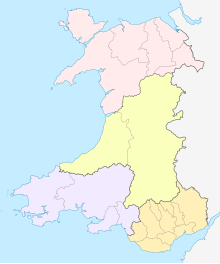Subdivisions of Wales
The subdivisions of Wales constitute a hierarchy of administrative divisions and non-administrative ceremonial areas.In the south east, Norman advancement led to the creation of marcher lordships, such as Glamorgan, which served as semi-autonomous administrative divisions, although these were not counties in the true sense as they lacked the formal structure.Before the end of the century, Flintshire had also become a county, and thus nearly half the territory of Wales was under the rule of the English Crown.[8] CJCs have powers relating to economic well-being, strategic planning and the development of regional transport policies.Before Brexit, as part of the European Union and Eurostat, the system used was Nomenclature of Territorial Units for Statistics (NUTS).Wales is divided into various electoral districts: There are seven cities in total in Wales: in addition to the four principal areas with city status (Cardiff, Swansea, Newport and Wrexham), the communities of Bangor, St Davids and St Asaph also have the status.The petition was refused as, unlike St Davids, there was no evidence of any charter or letters patent in the past conferring the status.[10] However, city status was finally granted to St Asaph in 2012 as part of the Queen's Diamond Jubilee celebrations:[11] St Asaph was selected "to recognise its wealth of history, its cultural contribution and its metropolitan status as a centre for technology, commerce and business".

local governmentprincipal areascommunitiesPrincipal areas of WalesLocal Government (Wales) Act 1994Blaenau GwentBridgendCaerphillyCardiffCarmarthenshireCeredigionDenbighshireFlintshireGwyneddIsle of AngleseyMerthyr TydfilMonmouthshireNeath Port TalbotNewportPembrokeshireRhondda Cynon TafSwanseaTorfaenVale of GlamorganWrexhamCommunity (Wales)List of communities in Walescommunity councilsparish councilscity statuscommunity meetingdirect democracyPreserved counties of Walespreserved countiesMid GlamorganSouth GlamorganWest GlamorganDistricts of WalesHistoric counties of WalesLocal Government Act 1972county boroughscantrefcommoteList of hundreds of WalesRegions of WalesNorth Wales CJCMid Wales CJCSouth West Wales CJCSouth East Wales CJCCorporate Joint Committeesregional economic growth dealsCardiff Capital RegionSwansea Bay City RegionGrowing Mid WalesAmbition North WalesMid WalesNorth WalesSouth East WalesSouth West WalesSenedd electoral regionspolice forcesDyfed-Powys PoliceGwent PoliceNorth Wales PoliceSouth Wales Policefire and rescue servicesMid and West Wales Fire and Rescue ServiceNorth Wales Fire and Rescue ServiceSouth Wales Fire and Rescue Servicelocal health boardsBetsi Cadwaladr University Health BoardPowys Teaching Health BoardHywel Dda University Health BoardAneurin Bevan University Health BoardCwm Taf Morgannwg University Health BoardSwansea Bay University Health BoardCardiff and Vale University Health BoardTrunk road agenttrunk roadsmotorwaysWelsh Government traffic officersNorth and Mid WalesSouth WalesNorth and Mid Wales Trunk Road AgentSouth Wales Trunk Road AgentOffice for National StatisticsInternational Territorial LevelBrexitEuropean UnionEurostatNomenclature of Territorial Units for StatisticsScotlandNorthern Ireland9 statistical regions of EnglandWest Wales and the ValleysRhondda Cynon TaffEast WalesUK Parliament constituencies in WalesSenedd constituencies and electoral regionsList of electoral wards in WalesList of built-up areas in Wales by populationList of cities in Walesletters patentBangorSt DavidsSt Asaph1911 Encyclopædia BritannicaDiamond JubileePlatinum JubileeSubdivisions of EnglandThe London GazetteList of topicsHistoryTimelineBibliographyPrehistoryRoman EraAnglo-Welsh WarsEarly Middle AgesKingdom of GwyneddKingdom of PowysDeheubarthMedieval Welsh lawNorman invasionEdwardian conquestLate Middle Ages